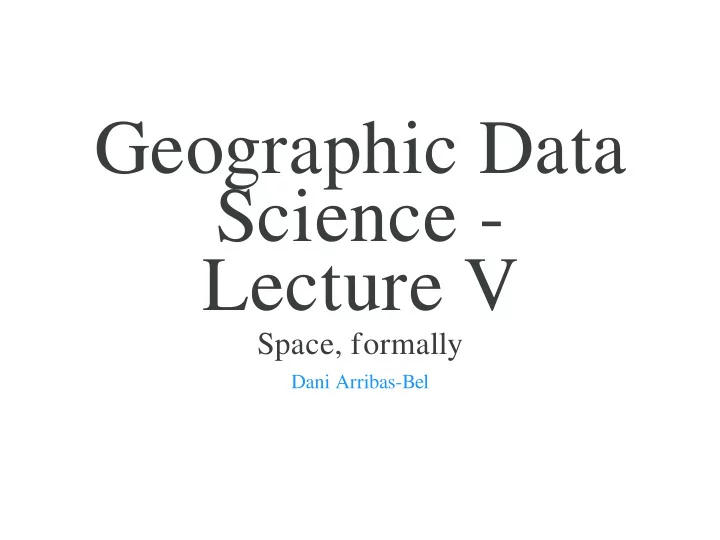

Geographic Data Science - Lecture V Space, formally Dani Arribas-Bel
Today The need to represent space formally Spatial weights matrices What Why Types The spatial lag The Moran Plot
Space, formally
For a statistical method to be explicitly spatial , it needs to contain some representation of the geography, or spatial context
For a statistical method to be explicitly spatial , it needs to contain some representation of the geography, or spatial context One of the most common ways is through Spatial Weights Matrices
(Geo)Visualization : translating numbers into a (visual) language that the human brain "speaks better" Spatial Weights Matrices : translating geography into a (numerical) language that a computer "speaks better" .
Core element in several spatial analysis techniques: Spatial autocorrelation Spatial clustering / geodemographics Spatial regression
W as a formal representation of space
W N x N positive matrix
W N x N positive matrix that contains spatial relations
W N x N positive matrix that contains spatial relations between all the observations in the sample
W N x N positive matrix that contains spatial relations between all the observations in the sample x > 0 if i and j are neighbors = { } w ij 0 otherwise wii = 0 by convention
W N x N positive matrix that contains spatial relations between all the observations in the sample x > 0 if i and j are neighbors = { } w ij 0 otherwise wii = 0 by convention ...What is a neighbor ???
Types of W A neighbor is "somebody" who is: Next door Close In the same "place" as us ...
Types of W A neighbor is "somebody" who is: Next door → Contiguity -based W s Close In the same "place" as us ...
Types of W A neighbor is "somebody" who is: Next door → Contiguity -based W s Close → Distance -based W s In the same "place" as us ...
Types of W A neighbor is "somebody" who is: Next door → Contiguity -based W s Close → Distance -based W s In the same "place" as us → Block weights ...
Contiguity-based weights Sharing boundaries to any extent Rook Queen ...
Distance-based weights Weight is (inversely) proportional to distance between observations Inverse distance (threshold) KNN (fixed number of neighbors) ...
Block weights Weights are assigned based on discretionary rules loosely related to geography For example: LSOAs into MSOAs Post-codes within city boundaries Counties within states ...
Other types of weights Combinations of the above Kernel Statistically-derived ... See Anselin & Rey (2014) for an in-detail discussion.
How much of a neighbor? No neighbors receive zero weight: wij = 0 Neighbors, it depends, wij can be: One wij = 1 → Binary Some proportion (0 < wij < 1, continuous ) which can be a function of: Distance Strength of interaction (e.g. commuting flows, trade, etc.) ...
Choice of W Should be based on and reflect the underlying channels of interaction for the question at hand. Examples: Processes propagated by inmediate contact (e.g. disease contagion) → Contiguity weights Accessibility → Distance weights Effects of county differences in laws → Block weights
Do your own (contiguity) weights time!
Standardization In some applications (e.g. spatial autocorrelation) it is common to standardize W The most widely used standardization is row-based : divide every element by the sum of the row: w ij ¯ = w ij w i ⋅ w i ⋅ where is the sum of a row.
The spatial lag
The spatial lag Product of a spatial weights matrix W and a given variably Y
The spatial lag Product of a spatial weights matrix W and a given variably Y Ysl = WY ysl − i = ∑ jwijyj
Measure that captures the behaviour of a variable in the neighborhood of a given observation i . If W is standardized , the spatial lag is the average value of the variable in the neighborhood
Common way to introduce space formally in a statistical framework Heavily used in both ESDA and spatial regression to delineate neighborhoods. Examples: Moran's I LISAs Spatial models (lag, error...)
Moran Plot
Moran Plot Graphical device that displays a variable on the horizontal axis against its spatial lag on the vertical one y − mean ( y ) Usually, variables are standardized ( ), which std ( y ) divides the space into quadrants Tool to start exploring spatial autocorrelation
Moran Plot
Moran Plot
Recapitulation
Recapitulation Spatial Weights matrices: matrix encapsulation of space Different types for different cases Useful in many contexts, like the spatial lag and Moran plot, but also many other things!
Geographic Data Science'15 - Lecture 5 by Dani Arribas-Bel is licensed under a Creative Commons Attribution-NonCommercial- ShareAlike 4.0 International License .
Recommend
More recommend